Summer weather always brings out all sorts of fascinating critters, and along with the delicious fresh produce that fills gardens and grocery shelves at this time of the year, there is a bumper crop of marvelous books dedicated to critters from pests to pets. As most teachers know, fiction books featuring animals tend to be popular with elementary and middle school readers, and readers of all ages gravitate to nonfiction titles featuring strange insects and ocean dwellers—and if the photos in those books are large and contain close-ups, so much the better. This week’s book reviews from the Children’s Literature and Reading Special Interest Group focus on books containing animals of all sorts, some contributing in immeasurable ways to our lives and some simply oddly fascinating.
Ages 4–8
Cicada. Michael Shoulders. 2015. Cherry Lake.
 What first seem like perfectly preserved insect carcasses to observant youngsters in the warm summer months are soon discovered to be the crunchy, translucent shells of cicadas found on the ground or attached to trees. This species seems to have a hard life, and not just because they shed their outer surface as they grow. Along with photos of cicadas at different life stages in, this well-written, entertaining, and informative book describes the mating habits of cicadas and how, after hatching on a tree leaf and dropping to the ground, the cicada nymphs must tunnel to the surface of the earth and lie buried for long periods of time. There are plenty of intriguing facts on this interesting species, about which much is still unknown. Other titles in this series feature the ant, grasshopper, honeybee, and katydid.
What first seem like perfectly preserved insect carcasses to observant youngsters in the warm summer months are soon discovered to be the crunchy, translucent shells of cicadas found on the ground or attached to trees. This species seems to have a hard life, and not just because they shed their outer surface as they grow. Along with photos of cicadas at different life stages in, this well-written, entertaining, and informative book describes the mating habits of cicadas and how, after hatching on a tree leaf and dropping to the ground, the cicada nymphs must tunnel to the surface of the earth and lie buried for long periods of time. There are plenty of intriguing facts on this interesting species, about which much is still unknown. Other titles in this series feature the ant, grasshopper, honeybee, and katydid.
Guess What: Twisty Tails. Kelly Calhoun. 2015. Cherry Lake.
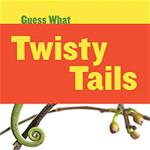 With carefully chosen vocabulary perfect for beginning readers yet interesting enough to keep them engaged, this book is essentially an animal guessing game. Readers examine textual and visual hints through text and photographs that allow them to figure out what the animal is. The clues become easier throughout the book, and it concludes with five interesting facts about the animal as well as a brief glossary. The title cleverly informs readers about one of the characteristics for which the animal is best known. This, and all the titles in this series, would be excellent introductory animal books for an elementary science classroom or a home library. Additional titles in the Guess What series are Guess What: Fast and Flightless, Guess What: Feathered and Fierce, Guess What: Fiercely Feline, Guess What: Flashy Feathers, Guess What: High-Speed Hoppers, Guess What: Majestic Manes, Guess What: Poised and Pink, Guess What: Scaly Swimmers, Guess What: Slinky Sliders, Guess What: Sneaky Snouts, and Guess What: Spotted Singers (all written by Kelly Calhoun).
With carefully chosen vocabulary perfect for beginning readers yet interesting enough to keep them engaged, this book is essentially an animal guessing game. Readers examine textual and visual hints through text and photographs that allow them to figure out what the animal is. The clues become easier throughout the book, and it concludes with five interesting facts about the animal as well as a brief glossary. The title cleverly informs readers about one of the characteristics for which the animal is best known. This, and all the titles in this series, would be excellent introductory animal books for an elementary science classroom or a home library. Additional titles in the Guess What series are Guess What: Fast and Flightless, Guess What: Feathered and Fierce, Guess What: Fiercely Feline, Guess What: Flashy Feathers, Guess What: High-Speed Hoppers, Guess What: Majestic Manes, Guess What: Poised and Pink, Guess What: Scaly Swimmers, Guess What: Slinky Sliders, Guess What: Sneaky Snouts, and Guess What: Spotted Singers (all written by Kelly Calhoun).
My Dog, Bob. Richard Torrey. 2015. Holiday House.
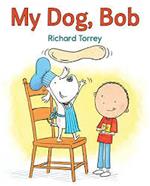 Anyone who spends time with a dog knows just how smart, clever, and obedient this family pet is. But sometimes the talents of a canine are not meant for public display. In the case of Jeff's extraordinary dog Bob, Bob is completely disinterested in fetching a stick, sitting on command, or speaking when told to do so. To his master’s dismay, he ignored the challenges laid down by Mimi, a neighbor, who shows off her dog Truffles while Bob merely watches. But as readers realize at the story’s conclusion, Bob can do so much more that. After all, he can easily prepare delicious meals for the family, but that can be their secret. The watercolor and oil pencil illustrations and the sparse text will warm the hearts of dog lovers who know just how exceptional their dogs are.
Anyone who spends time with a dog knows just how smart, clever, and obedient this family pet is. But sometimes the talents of a canine are not meant for public display. In the case of Jeff's extraordinary dog Bob, Bob is completely disinterested in fetching a stick, sitting on command, or speaking when told to do so. To his master’s dismay, he ignored the challenges laid down by Mimi, a neighbor, who shows off her dog Truffles while Bob merely watches. But as readers realize at the story’s conclusion, Bob can do so much more that. After all, he can easily prepare delicious meals for the family, but that can be their secret. The watercolor and oil pencil illustrations and the sparse text will warm the hearts of dog lovers who know just how exceptional their dogs are.
Over in the Wetlands: A Hurricane-on-the-Bayou Story. Caroline Starr Rose. Ill. Rob Dunlavy. 2015. Schwartz & Wade.
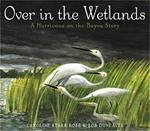 Natural disasters such as hurricanes often bring to mind the destruction they wreak on manmade structures, but as this nonfiction title vividly illustrates, they also affect nature in many ways. Filled with stunning images, created with watercolor, ink, pencil, paint, collage, and Adobe Photoshop, this book provides readers with a ringside seat on nature’s fierceness. Just as humans place plywood boards on their windows and stock up on supplies, so do the denizens of the wetlands: Pelicans, alligators, fish, and turtles prepare for the onslaught of the storm’s fierce winds and waves. The rhyming text evokes the hurricane wind: “Pounding,/wailing,/hours endless./Blasting,/breaking/storm's relentless.” Readers may be mesmerized by the winds’ brutal power followed by a calm aftermath. An afterword describes the importance of the U.S. wetlands and the challenges that lie ahead for the Louisiana region because of the encroachment of humans on this natural resource. This title might be worth sharing on this, the 10th anniversary of Hurricane Katrina and the destruction it brought to the Gulf Coast and New Orleans.
Natural disasters such as hurricanes often bring to mind the destruction they wreak on manmade structures, but as this nonfiction title vividly illustrates, they also affect nature in many ways. Filled with stunning images, created with watercolor, ink, pencil, paint, collage, and Adobe Photoshop, this book provides readers with a ringside seat on nature’s fierceness. Just as humans place plywood boards on their windows and stock up on supplies, so do the denizens of the wetlands: Pelicans, alligators, fish, and turtles prepare for the onslaught of the storm’s fierce winds and waves. The rhyming text evokes the hurricane wind: “Pounding,/wailing,/hours endless./Blasting,/breaking/storm's relentless.” Readers may be mesmerized by the winds’ brutal power followed by a calm aftermath. An afterword describes the importance of the U.S. wetlands and the challenges that lie ahead for the Louisiana region because of the encroachment of humans on this natural resource. This title might be worth sharing on this, the 10th anniversary of Hurricane Katrina and the destruction it brought to the Gulf Coast and New Orleans.
Playful Pigs From A to Z. Anita Lobel. 2015. Knopf Books for Young Readers.
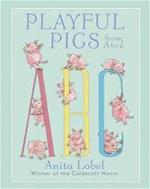 Twenty-six handsome and playful pigs scamper through the letters of the alphabet in this ABC book illustrated beautifully with gouache and watercolor scenes. After slipping out of their pigpen and sauntering through the countryside, they have no trouble finding adventures aplenty. As might be expected, each of these porcine individuals has a name, starting with Amanda Pig and ending with Zeke Pig, appropriately. Alongside each pig, the author has placed a short sentence containing a word that starts with the pig’s particular letter of the alphabet. Including the entire alphabet at the bottom of each page allows beginning readers to consider the placement of each featured alphabetical letter on the book’s pages. Delightful and creative, there is no doubt that title will keep emergent readers engaged and learning for long periods of time.
Twenty-six handsome and playful pigs scamper through the letters of the alphabet in this ABC book illustrated beautifully with gouache and watercolor scenes. After slipping out of their pigpen and sauntering through the countryside, they have no trouble finding adventures aplenty. As might be expected, each of these porcine individuals has a name, starting with Amanda Pig and ending with Zeke Pig, appropriately. Alongside each pig, the author has placed a short sentence containing a word that starts with the pig’s particular letter of the alphabet. Including the entire alphabet at the bottom of each page allows beginning readers to consider the placement of each featured alphabetical letter on the book’s pages. Delightful and creative, there is no doubt that title will keep emergent readers engaged and learning for long periods of time.
Ages 9–11
From the Notebooks of a Middle School Princess. Meg Cabot. 2015. Feiwel & Friends.
 Fans of the Princess Diaries are sure to love this title, part of a new series about a New Jersey middle school princess who has no idea that she has royal connections. While Olivia Grace Clarisse Mignonette Harrison has no idea how to handle Annabelle, a school bully who is jealous of her, she clearly has a way with dogs. In fact, once she is swept up by a limousine and brought to a swanky New York City hotel, she quickly befriends the royal pets, Snowball, who becomes hers, and Rommel, who never likes anyone, but does like the princess. The youngster has never met her father and had no clue that she is related to someone royal. Except for her talent in art, Olivia really isn’t all that different from her classmates at Cranbrook Middle School. Still, she is simply endearing, making the best of her lonely existence and second-class status with her aunt’s family, and then grateful at the good fortune that comes her way once her true identity is revealed. The wonder of it all is that she is thankful to have a loving family, not that she’s so glad to have all that wealth and privilege. As most dog lovers can tell you, dogs are good judges of character, and they don’t miss in assessing Olivia’s worthiness.
Fans of the Princess Diaries are sure to love this title, part of a new series about a New Jersey middle school princess who has no idea that she has royal connections. While Olivia Grace Clarisse Mignonette Harrison has no idea how to handle Annabelle, a school bully who is jealous of her, she clearly has a way with dogs. In fact, once she is swept up by a limousine and brought to a swanky New York City hotel, she quickly befriends the royal pets, Snowball, who becomes hers, and Rommel, who never likes anyone, but does like the princess. The youngster has never met her father and had no clue that she is related to someone royal. Except for her talent in art, Olivia really isn’t all that different from her classmates at Cranbrook Middle School. Still, she is simply endearing, making the best of her lonely existence and second-class status with her aunt’s family, and then grateful at the good fortune that comes her way once her true identity is revealed. The wonder of it all is that she is thankful to have a loving family, not that she’s so glad to have all that wealth and privilege. As most dog lovers can tell you, dogs are good judges of character, and they don’t miss in assessing Olivia’s worthiness.
Unleashed. Gordon Korman. 2015. Scholastic.
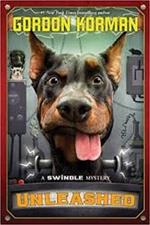 In this seventh title in the Swindle series, Griffin Bing and his friends are divided suddenly in a gender war, boys against girls. The rift results from the pressure Griffin feels to win the school’s competition for best invention. He’s pitted against arch-enemy Darren Vader and his good friend Melissa. As Griffin and his crew experiment with ways to muffle the sound of a vacuum cleaner, Melissa crafts an invention that will prevent Luthor, Savannah’s beloved and reformed attack dog, from chasing after the exterminator’s truck. There are plenty of hair-raising adventures, some questionable activities, and close calls within the book’s pages. Fans of this series will not be disappointed, as each character has a chance to shine. As always, the author hooks readers until the very last page, when Luthor’s reasons for chasing the truck become all too clear. There’s no one better at coming up with interesting plots, terrific characters, and authentic dialogue, all wrapped in a layer of sophisticated humor and canine affection than Korman. It’s a dog lovers’ delight.
In this seventh title in the Swindle series, Griffin Bing and his friends are divided suddenly in a gender war, boys against girls. The rift results from the pressure Griffin feels to win the school’s competition for best invention. He’s pitted against arch-enemy Darren Vader and his good friend Melissa. As Griffin and his crew experiment with ways to muffle the sound of a vacuum cleaner, Melissa crafts an invention that will prevent Luthor, Savannah’s beloved and reformed attack dog, from chasing after the exterminator’s truck. There are plenty of hair-raising adventures, some questionable activities, and close calls within the book’s pages. Fans of this series will not be disappointed, as each character has a chance to shine. As always, the author hooks readers until the very last page, when Luthor’s reasons for chasing the truck become all too clear. There’s no one better at coming up with interesting plots, terrific characters, and authentic dialogue, all wrapped in a layer of sophisticated humor and canine affection than Korman. It’s a dog lovers’ delight.
Ages 12–14
Close to the Wind. Jon Walter. 2015. David Fickling.
 Although this book brings to mind the Holocaust and Nazi Germany, the author never specifies the story’s setting, which makes its appeal more wide reaching. Ten-year-old Malik and his grandfather are waiting to board a ship that will bring them to sanctuary. Ticket costs are quite steep, but the grandfather has hidden resources—a large diamond secreted in a tooth in his mouth. When two men with whom Papa is acquainted betray the old man, he scrambles to get his grandson on that ship. Malik constantly annoys his grandfather with questions and his interest in a stray cat he befriends. Once Malik and the cat, eventually named Booty by the purser, are on board the ship, he is placed with other orphans who offer survival tips. A chance encounter with the sons of the men who betrayed his grandfather leads to his agreeing to a trade, and Malik is torn between his conflicting thoughts about what he values. The affection he has for Booty, the only thing from his former life, is quite understandable and moving for readers. The book is compelling, heartrending, and ends on the perfect note. Clearly, access to money can make life much easier, but it isn’t what matters. A fantastic debut that will stay with readers long after they have reached the last page, the book explores loyalty, compassion, generosity, and treachery, encouraging readers to explore what they might have done had they been in the characters’ shoes.
Although this book brings to mind the Holocaust and Nazi Germany, the author never specifies the story’s setting, which makes its appeal more wide reaching. Ten-year-old Malik and his grandfather are waiting to board a ship that will bring them to sanctuary. Ticket costs are quite steep, but the grandfather has hidden resources—a large diamond secreted in a tooth in his mouth. When two men with whom Papa is acquainted betray the old man, he scrambles to get his grandson on that ship. Malik constantly annoys his grandfather with questions and his interest in a stray cat he befriends. Once Malik and the cat, eventually named Booty by the purser, are on board the ship, he is placed with other orphans who offer survival tips. A chance encounter with the sons of the men who betrayed his grandfather leads to his agreeing to a trade, and Malik is torn between his conflicting thoughts about what he values. The affection he has for Booty, the only thing from his former life, is quite understandable and moving for readers. The book is compelling, heartrending, and ends on the perfect note. Clearly, access to money can make life much easier, but it isn’t what matters. A fantastic debut that will stay with readers long after they have reached the last page, the book explores loyalty, compassion, generosity, and treachery, encouraging readers to explore what they might have done had they been in the characters’ shoes.
Stormstruck! John Macfarlane. 2015. Holiday House.
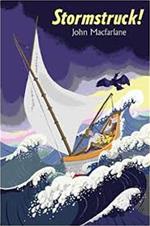 Twelve-year-old Sam hasn’t really processed the death of his brother Steve who was killed in military service. But he takes seriously his promise to take care of Steve’s Labrador, Pogo. After overhearing his parents discussing putting Pogo, who has cancer, to sleep, Sam decides to head out to a nearby island. His plans are vague, but he has the good fortune to meet Magnus, a retired ornithologist, and his crippled bird. After sharing a meal and a chat, he tries to go home but is delayed by dense fog and a series of accidents and mistakes. Through it all, Steve is with him in the form of survival tips he shared with his brother. The author piles on the suspense, providing riveting details of how helpless Sam feels when he is unable to see where the boat is going and his wariness of the shark nearby. This adventure story featuring one boy against the elements will appeal to animal lovers and anyone with a tender place in the heart for seemingly hopeless causes. As sick and frail as Pogo is, he still keeps watch over Sam, often with no concern about his own welfare. To entice readers to give this action-filled survival story a try, teachers should read aloud one of the compelling passages with which it is filled.
Twelve-year-old Sam hasn’t really processed the death of his brother Steve who was killed in military service. But he takes seriously his promise to take care of Steve’s Labrador, Pogo. After overhearing his parents discussing putting Pogo, who has cancer, to sleep, Sam decides to head out to a nearby island. His plans are vague, but he has the good fortune to meet Magnus, a retired ornithologist, and his crippled bird. After sharing a meal and a chat, he tries to go home but is delayed by dense fog and a series of accidents and mistakes. Through it all, Steve is with him in the form of survival tips he shared with his brother. The author piles on the suspense, providing riveting details of how helpless Sam feels when he is unable to see where the boat is going and his wariness of the shark nearby. This adventure story featuring one boy against the elements will appeal to animal lovers and anyone with a tender place in the heart for seemingly hopeless causes. As sick and frail as Pogo is, he still keeps watch over Sam, often with no concern about his own welfare. To entice readers to give this action-filled survival story a try, teachers should read aloud one of the compelling passages with which it is filled.
Survival Strategies of the Almost Brave. Jen White. 2015. Farrar, Straus and Giroux.
 This book scared me to death! Not in a Stephen King–horror way, but in an edge-of-the seat-worry-about-what-might-happen way for the two sisters at the story’s heart. I kept thinking about all the terrible individuals they could have encountered and keeping my fingers crossed they would be OK. After the death of their mother, 12-year-old Liberty and her 8-year-old sister Billie stay with their mother’s friend Julie until some sort of arrangement can be sorted out. Although they’ve hardly had contact with their father, he agrees to take responsibility for them, and they spend the summer roaming the Southwest. But he isn’t up to the task, and the girls find themselves left behind at a gas station. With a little luck and a lot of pluck, they take matters into their own hands and do what they have to do as they try to find a way back to San Diego. Middle-grade readers will find Liberty’s notebook filled with animal facts and the way she sees the world in terms of predators and prey and survival fascinating. It’s hard to resist some of their benefactors, most of whom have no idea that they’re helping the girls. In the end, as Liberty realizes that she has plenty of folks who care about her, she also decides that she can form her own pod, as whales do, and surround herself with supportive individuals—a good reminder for all readers. This is a fine authorial debut, filled with strong writing and vivid word paintings that make her characters unforgettable. I love the book cover, too.
This book scared me to death! Not in a Stephen King–horror way, but in an edge-of-the seat-worry-about-what-might-happen way for the two sisters at the story’s heart. I kept thinking about all the terrible individuals they could have encountered and keeping my fingers crossed they would be OK. After the death of their mother, 12-year-old Liberty and her 8-year-old sister Billie stay with their mother’s friend Julie until some sort of arrangement can be sorted out. Although they’ve hardly had contact with their father, he agrees to take responsibility for them, and they spend the summer roaming the Southwest. But he isn’t up to the task, and the girls find themselves left behind at a gas station. With a little luck and a lot of pluck, they take matters into their own hands and do what they have to do as they try to find a way back to San Diego. Middle-grade readers will find Liberty’s notebook filled with animal facts and the way she sees the world in terms of predators and prey and survival fascinating. It’s hard to resist some of their benefactors, most of whom have no idea that they’re helping the girls. In the end, as Liberty realizes that she has plenty of folks who care about her, she also decides that she can form her own pod, as whales do, and surround herself with supportive individuals—a good reminder for all readers. This is a fine authorial debut, filled with strong writing and vivid word paintings that make her characters unforgettable. I love the book cover, too.
Won Ton and Chopstick: A Cat and Dog Tale Told in Haiku. Lee Wardlaw. Ill. Eugene Yelchin. 2015. Henry Holt.
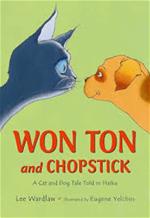 A series of Japanese Senryu poems highlights the relationship between a cat and a dog. Readers of Won Ton (2011), the book’s predecessor, will recognize the independent—and possessive—feline from that earlier charming poetry book. From his first sighting of the interloper, “My eyes full of doom” to their initial uneasy encounters and all the way to their collective morning assault on their boy as two “furry alarm clocks!” the verses honor a feline, an only child, who learns to coexist peacefully with a dog. Created with graphite and gouache, the illustrations feature winsome facial expressions and body language. This book is perfect for teaching students about voice in writing because of Won Ton’s distinctive feline voice. Every word captures Won Ton’s dismay at being possibly supplanted in the family hierarchy.
A series of Japanese Senryu poems highlights the relationship between a cat and a dog. Readers of Won Ton (2011), the book’s predecessor, will recognize the independent—and possessive—feline from that earlier charming poetry book. From his first sighting of the interloper, “My eyes full of doom” to their initial uneasy encounters and all the way to their collective morning assault on their boy as two “furry alarm clocks!” the verses honor a feline, an only child, who learns to coexist peacefully with a dog. Created with graphite and gouache, the illustrations feature winsome facial expressions and body language. This book is perfect for teaching students about voice in writing because of Won Ton’s distinctive feline voice. Every word captures Won Ton’s dismay at being possibly supplanted in the family hierarchy.
Ages 15+
The Dogs. Allan Stratton. 2015. Anderson.
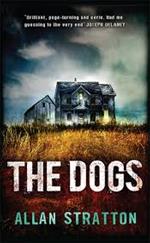 On the run from his abusive father, Cameron and his mother settle into a remote town far from his reach—or so they believe. Just as they think that their five years of avoiding him may be over and that they’re safe, Cameron makes a mistake, contacts his father, and sets into motion a frightening chain of events. If that were all that the book was about, it would be engaging. But its additional layers of suspense and the hints dropped about Cam’s own mental health and the bullies he faces at school make it even more intriguing. Teen readers won’t be sure what to believe or who to trust. It seems that the old house in which Cam and his mother are living has secrets about its previous inhabitants, and Cam may—or may not—be seeing and hearing things, including barking, growling, snarling dogs. Watching the author unspool this story and then reel in his readers was a compelling experience since it skirts so closely to madness before dipping back to reality time and again. Be careful not to read this as dusk is falling or while you are alone because it may send chills down your spine every time you hear the neighborhood dogs howling or feel their breaths at your back.
On the run from his abusive father, Cameron and his mother settle into a remote town far from his reach—or so they believe. Just as they think that their five years of avoiding him may be over and that they’re safe, Cameron makes a mistake, contacts his father, and sets into motion a frightening chain of events. If that were all that the book was about, it would be engaging. But its additional layers of suspense and the hints dropped about Cam’s own mental health and the bullies he faces at school make it even more intriguing. Teen readers won’t be sure what to believe or who to trust. It seems that the old house in which Cam and his mother are living has secrets about its previous inhabitants, and Cam may—or may not—be seeing and hearing things, including barking, growling, snarling dogs. Watching the author unspool this story and then reel in his readers was a compelling experience since it skirts so closely to madness before dipping back to reality time and again. Be careful not to read this as dusk is falling or while you are alone because it may send chills down your spine every time you hear the neighborhood dogs howling or feel their breaths at your back.
Last of the Sandwalkers. Jay Hosler. 2015. First Second.
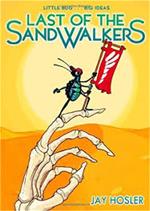 It might be a stretch for most of us to envision a complicated insect world where a group of explorers boldly go where no one else has gone before. But the book’s creator has done just that in a way that makes the insects themselves come to life in believable ways. Not only do Lucy, the scientist who is leading the expedition beyond these insects’ known world, and her companions have personality quirks and habits that make them seem real, but also they are imperfect and splendid in their wonder at the things they are stumbling upon. Readers can certainly enjoy the book just for its story or to see similarities between these beetles and we humans as they realize that they are not the only living things found on earth while navigating complicated family dynamics and dealing with political intrigue and treachery. Hmm...it sounds like higher education and academia, doesn’t it? The annotations at the end of the title add plenty of interesting science to an already fascinating book. I hope there will be more forthcoming.
It might be a stretch for most of us to envision a complicated insect world where a group of explorers boldly go where no one else has gone before. But the book’s creator has done just that in a way that makes the insects themselves come to life in believable ways. Not only do Lucy, the scientist who is leading the expedition beyond these insects’ known world, and her companions have personality quirks and habits that make them seem real, but also they are imperfect and splendid in their wonder at the things they are stumbling upon. Readers can certainly enjoy the book just for its story or to see similarities between these beetles and we humans as they realize that they are not the only living things found on earth while navigating complicated family dynamics and dealing with political intrigue and treachery. Hmm...it sounds like higher education and academia, doesn’t it? The annotations at the end of the title add plenty of interesting science to an already fascinating book. I hope there will be more forthcoming.
Barbara A. Ward teaches graduate and undergraduate courses in literacy at Washington State University, Pullman. She spent 25 years teaching in the public schools of New Orleans, where she worked with students at every grade level, from kindergarten through high school as well as several ability levels. She is certified in elementary education, English education, and gifted education. She holds a bachelor's in communications and a master's in English Education from the University of Tennessee and a PhD in Curriculum and Instruction from the University of New Orleans.
These reviews are submitted by members of the International Reading Association's Children's Literature and Reading Special Interest Group (CL/R SIG)and are published weekly on Literacy Daily.